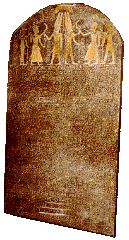What has archeology taught us about the origins of Israel?

Undoubtedly, the most important mention of Israel outside the Bible is that in the Merneptah, or “Israel,” Stela. Discovered in 1896 in Merneptah's mortuary temple in Thebes by Flinders Petrie, the stela is a poetic eulogy to pharaoh Merneptah, who ruled Egypt after Rameses the Great, ca. 1212-1202 BC. Of significance to Biblical studies is a short section at the end of the poem describing a campaign to Canaan by Merneptah in the first few years of his reign, ca. 1210 BC. One line mentions Israel: “Israel is laid waste, its seed is not.” Here we have the earliest mention of Israel outside the Bible and the only mention of Israel in Egyptian records.
Since the date of the reference to Israel in the Merneptah Stela is during the time of the judges, prior to the establishment of the monarchy, it is of crucial importance to understanding Israel's formative period. For example, a popular theory among Biblical scholars today is that Israel emerged from peoples indigenous to Canaan in the mid 12th century BC. If this is true, then Biblical history and chronology prior to ca. 1150 BC would have to be jettisoned.
Proponents of the “12th century emergence theory” maintain that the Israelites did not come into Canaan from outside to conquer the land around 1400 BC, as the Bible indicates. The emergence scenario would also reject the historicity of the Wilderness Wanderings, Exodus, Egyptian Sojourn and the Patriarchal narratives. However, if Israel were an established entity in Canaan already in 1210 BC, as the Merneptah Stela implies, then the 12th century emergence theory would be refuted (Bimson 1991). If Israel was well established by the end of the 13th century, it could not have come into being in the middle of the next century.
As a result, the Merneptah Stela has been meticulously scrutinized and analyzed by scholars, perhaps more so than any text outside the Bible. They are out to determine what it “really” says, not that they would want to force any preconceived notions on the text! Michael G. Hasel, a doctoral candidate at the University of Arizona, has recently reviewed the various interpretations concerning the reference to Israel in the stela. Furthermore, he has done an in-depth linguistic study to determine, as far as possible, the intended meaning of text.
The discussion of the significance of Israel in the Merneptah stela revolves around the meaning of two words: “Israel” and “seed.” A number of possibilities have been suggested, as summarized by Hasel. Scholars have implied that the name Israel could be interpreted as Iezreel or Jezreal, the valley to the north of the country. Another idea is that the name has a descriptive meaning (“the wearers of the side lock”) and applies to the Libyans. Or, in the time of Merneptah, the name Israel was a geographic term referring to a territory corresponding to Canaan. Hasel discusses the problems associated with each of these interpretations and concludes,
Israel, identified by the determinative for people, is a socioethnic unity powerful enough to be mentioned along with major city-states that were also neutralized (1994: 51).
Turning to the meaning of the Egyptian word prt, “seed,” there are only two possibilities, “grain” or “offspring.” Based on the use of prt in other Egyptian texts, Hasel deduces that it refers to grain. Thus, the phrase “its seed is not” indicates that Israel's food supply was no longer in existence. Hasel observes,
We may perceive Israel within the context and information of the Merneptah stela to be a rural sedentary group of agriculturalists without its own urban city-state support system (1994:54).
This is exactly the picture we have of Israel from the Old Testament. Gideon lived close to the time of the Merneptah Stela, and he was a farmer living in a small village (Judges 6).
Archaeological evidence supports the fact that the Israelites were agriculturalists in the late 13th century BC. Grain storage pits were a common feature of hill country sites of this period. Teeth from a tomb dating to ca. 1200 BC excavated by the Associates for Biblical Research at Kh. Nisya indicate that the inhabitants of the site ate grain.
Hasel's study of the Merneptah Stela is extremely important. It clears up a number of misconceptions and focuses attention on the true significance of the stela. It indicates that Israel was well established in Canaan in the late 13th century BC and was a significant political force to be reckoned with. Hasel concludes,
Israel functioned as an agriculturally-based/sedentary socioethnic entity in the late 13th century B.C., one that is significant enough to be included in the military campaign against political powers in Canaan. …While the Merneptah stela does not give any indication of the actual social structure of the people of Israel, it does indicate that Israel was a significant socioethnic entity that needed to be reckoned with (1994: 54; 56, n. 12).
Scholars need to come to grips with these facts, which are entirely consistent with the Bible's description of Israel's origins.
Recommended for Further Reading
- Bimson, J.J. 1991 “Merenptah's Israel and recent Theories of Israelite Origins”. Journal for the Study of the Old Testament 49: 3-29.
- Hasel, M.G. 1994 “Israel in the Merneptah Stela”. Bulletin of the American Schools of Oriental Research 296: 45-61.
Author: Bryant G. Wood of Associates for Biblical Research.
More information
- Is there archaeological evidence of the sons of Jacob, the tribal leaders of Israel? Answer
- Is there evidence that the Israelites once lived in Egypt as the Bible says? And has Joseph’s original tomb been found? Answer
Copyright © 1995, Associates for Biblical Research, All Rights Reserved—except as noted on attached “Usage and Copyright” page that grants ChristianAnswers.Net users generous rights for putting this page to work in their homes, personal witnessing, churches and schools.

